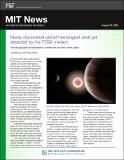Newly discovered planet has longest orbit yet detected by the TESS mission
Author(s)
Chu, Jennifer
Download2023-08-30-MIT News-Newly Discovered Planet Has Longest Orbit Yet Detected by the TESS Mission.pdf (740.9Kb)
Terms of use
Metadata
Show full item recordAbstract
More than 80 percent of confirmed exoplanets have orbits shorter than 50 days. Astronomers are starting to get a general picture of these planets’ formation, evolution, and composition. But the picture is much fuzzier for planets with longer orbital periods. Far-out worlds, with months- to years-long orbits, are more difficult to detect, and their properties have therefore been trickier to discern.
Now, the list of long-period planets has gained two entries. Astronomers at MIT, the University of New Mexico, and elsewhere have discovered a rare system containing two long-period planets orbiting TOI-4600, a nearby star that is 815 light years from Earth.
The discovery was made using data from NASA’s Transiting Exoplanet Survey Satellite, or TESS — an MIT-led mission that monitors the nearest stars for signs of exoplanets. The new, farther planet has the longest period that TESS has detected to date.
Date issued
2023-08-30Publisher
MIT News
Collections
The following license files are associated with this item: